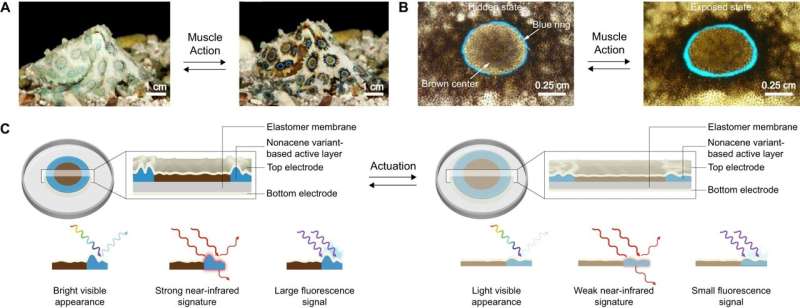January 8, 2024 feature
This article has been reviewed according to Science X's editorial process and policies. Editors have highlighted the following attributes while ensuring the content's credibility:
fact-checked
peer-reviewed publication
trusted source
proofread
Mimicking the masters: Octopus-inspired systems for deception and signaling

In a new study, scientists have introduced octopus-inspired deception and signaling systems using a stable nonacene-like molecule, marking a significant advancement in camouflage technology with potential applications in diverse fields.
Deception and signaling systems refer to mechanisms that allow for dynamic modulation of color and appearance. These systems are designed to deceive or signal observers by changing their visible and near-infrared characteristics.
Senior author Prof. Alon Gorodetsky from the University of California spoke to Tech Xplore about the team's motivation behind developing the system, saying, "My group has a long-standing fascination with the appearance-changing abilities of cephalopods, and this interest has inspired and driven much of our work."
Inspired by the blue-ringed octopus, Hapalochlaena lunulata, the research aims to replicate the animal's ability to dynamically alter its appearance as a form of communication or defense, showcasing unique capabilities for camouflage and signaling in various applications.
Drawing inspiration from nature
Hapalochlaena lunulata, renowned for its poisonous nature, is a small cephalopod with a size not exceeding 10 centimeters. Boasting distinctive blue rings measuring seven to eight millimeters in diameter, it has become a source of inspiration for innovative camouflage technologies.
The 60 vivid blue rings, scattered across its skin, serve as an aposematic adornment. This visual display warns potential predators of the octopus's highly venomous nature.
The octopus can alter the coloration of its mantle, displaying variable ring patterns that correlate with its surroundings, from yellow ocher to light brown or white-ish when inactive.
The octopus has a captivating flashing behavior, during which it displays its iridescent rings as a warning signal. Each flash lasts about a third of a second, creating a striking visual effect.
The researchers are particularly intrigued by the octopus's capacity to produce blue iridescence independently of external chemicals.
Nonacene-like molecule as the active material
To replicate the characteristics of the octopus, the researchers used a nonacene-like molecule as their active material.
Nonacene is a linearly fused polycyclic hydrocarbon with nine benzene rings. However, challenges in synthesis and stability have limited its exploration, hindering its potential application.
To overcome these challenges, the researchers designed and synthesized a novel nonacene-like molecule named tetrabenzononacene (TBN) with unique characteristics.
The molecule incorporates a linear arrangement of nine ortho-annulated benzene rings, creating a low bandgap for red-to-near-infrared absorbance. Additional fused aromatic rings enhance stability, and nitrogen heteroatoms offer responsiveness to chemical stimuli. Alkyl chain-functionalized phenyl rings improve solubility.
"The material plays a critical role in the devices' tunable spectroscopic and fluorescent properties and thus enables their multiple operating modes," explained Prof. Gorodetsky.
Upon analysis, the researchers found that TBN exhibited remarkable stability, outlasting TMS-pentacene, a benchmark for comparison, in harsh conditions.
Solid-state spectroscopy of TBN-based architectures showcased dynamic appearance changes upon actuation (movement), emphasizing the molecule's suitability for deception and signaling platforms.
Once they were satisfied with the nonacene-like molecule, the researchers applied it in a quad-layer dielectric elastomer actuator (DEA) device, mimicking the octopus's color-changing ability.
The DEA device's capabilities
The researchers successfully developed an octopus-inspired device that can change appearance and signal observers in the visible and near-infrared regions of the electromagnetic spectrum.
Noteworthy characteristics of these DEA devices include substantial areal strains, reaching an average of approximately 79% for the blue outer annuli and 45% for the brown inner circles at a bias of ~3.2 kV.
This means the devices can undergo significant and controlled deformations, allowing the blue and brown regions to expand laterally. The ability to achieve such high areal strains is crucial for the dynamic appearance-changing capabilities of the systems, enabling effective modulation of their visible and near-infrared characteristics.
The blue-brown annulated circles become noticeably lighter upon actuation with significant biases, creating a visible change in color and lightness. Additionally, the device exhibits rapid response, taking about 380 milliseconds, ensuring swift and efficient modulation of their appearance.
One factor that surprised the researchers was the device's stability. Prof. Gorodetsky said, "We were surprised by the general stability of our devices when operating continuously in the air and by their ability to self-repair after failure without any user intervention."
Impressively, the devices maintain stability over an extensive cycle life, with some devices showcasing consistent lightness modulation over 500 cycles.
Prof. Gorodetsky explained the self-repair mechanism of the device, saying, "The devices appear to fail through well-known dielectric breakdown and pinhole shorting mechanisms common and to then self-repair through local conversion of the nonacene-like molecule and/or acrylic elastomer into an insulating material. Such self-repair ensures that the devices can resume functioning even after becoming damaged."
Long-term use and future work
Even after being stored for over two years, the TBN-based architectures retained their actuation-dependent visible appearances, surface topologies, and spectroscopic characteristics, reaffirming the longevity and reliability of the nonacene-like molecule in practical applications.
The devices' ability to withstand challenging environmental conditions and exhibit autonomous self-repair positions them as promising candidates for next-generation deception and signaling platforms, where adaptability, stability, and responsiveness are paramount.
"Our devices are suitable for camouflage and signature management applications, and they could also be relevant for applications in displays, anti-counterfeiting, sensing, imaging, energy conservation, and robotics," explained Prof. Gorodetsky.
He and his team hope to explore the scalability of these or analogous octopus-inspired devices and further expand the scope of their applications.
The findings of the study are published in Nature Communications.
More information: Preeta Pratakshya et al, Octopus-inspired deception and signaling systems from an exceptionally-stable acene variant, Nature Communications (2023). DOI: 10.1038/s41467-023-40163-7.
© 2024 Science X Network




















